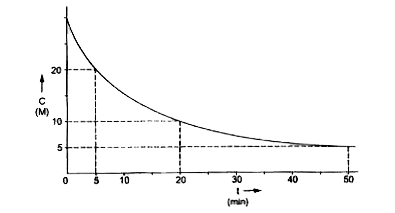The half life for a reaction between fixed conecntration of reactants varies with temperature as follows:
Calcutate the activation energy of this reaction.
The correct Answer is:
Use:
Topper's Solved these Questions
- BOOK - OP TANDONCHAPTER - CHEMICAL KINETICSEXERCISE - OBJECTIVE QUESTIONS (LEVEL-A)192videos
CHEMICAL KINETICS
- BOOK - OP TANDONCHAPTER - CHEMICAL KINETICSEXERCISE - OBJECTIVE QUESTIONS (LEVEL-B) SET I48videos
CHEMICAL KINETICS
- BOOK - OP TANDONCHAPTER - CHEMICAL KINETICSEXERCISE - ILLUSTRATIONS34videos
CHEMICAL KINETICS
- BOOK - OP TANDONCHAPTER - CARBOXYLIC ACIDS AND THEIR DERIVATIVESEXERCISE - Integer4videos
CARBOXYLIC ACIDS AND THEIR DERIVATIVES
- BOOK - OP TANDONCHAPTER - Chemical Thermodynamics and ThermochemistryEXERCISE - Self Assessment (Integer type).3videos
Chemical Thermodynamics and Thermochemistry
Similar Questions
For a reaction , the concentration of the reactant C varies with time t as shown by the following graph .

what do you conclude about the order of the reaction ?View SolutionFollowing are two first order reaction with their half times given at 25∘C.
At1/2=30min−−−−−−−→ Products
Bt1/2=40min−−−−−−−→ Products
The temperature coefficients of their reactions rates are 3 and 2, respectively, beween 25∘C and 35∘C. IF the above two resctions are carried out taking 0.4M of each reactant but at different temperatures: 25∘C for the first order reaction and 35∘C for the second order reaction, find the ratio of the concentrations of A and B after an hour.View Solution
Knowledge Check
- Question 1 - Select One
In a 1st order reaction, reactant concentration C varies with time t as:
A1/C increases linearly with tBlog C decreases linearly with tCC decreases with 1/tDlog C decreases with 1/t - Question 2 - Select One
In a 1st order reaction, reactant concentration C varies with time t as:
A1/C increases linearly with tBlog C decreases linearly with tCC decreases with 1/tDlog C decreases with 1/t - Question 3 - Select One
In a 1st order reaction, reactant concentration C varies with times t as:
A1C increase linearly with tBlogC decrease linearly with tCC decrease with 1tDlogC decrease with 1t
The rate constant 'k'. For a reaction varies with temperature 'T' according to the question. logk=logA−Ea2.303R(1T)
Where Ea is the activation energy. When a graph is plotted for logkvs1/T, a straight line with a slope of −4250 K is obtained. Calcualte Ea for this reaction.View SolutionIn a first order reaction , on plotting a graph between t1/2 and concentration of reactant
View SolutionHalf life (t12) of first order reaction is
View SolutionThe product of half life T1/2 and the square of initial concentration of the reactant (a) is constant. Then the order of reaction is
View SolutionConsider the following statements about first order reaction:
(1) The rate of reaction is directly proportional to the concentration of the reactant.
(2) Its half-life period is always constant.
(3) Concentration of reactant falls exponentially.
(4) It has low activation energy.
Of these statements:View Solution

